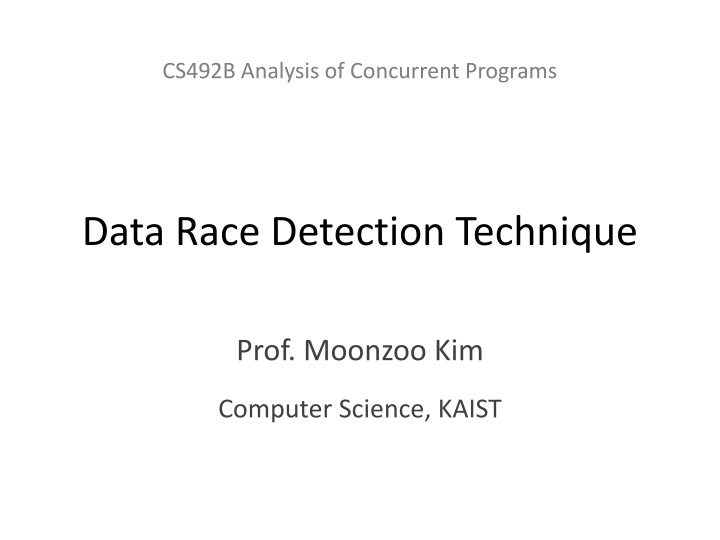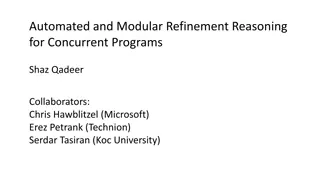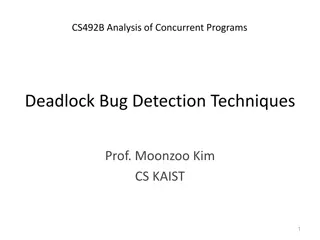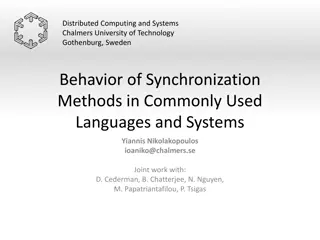Data Race in Concurrent Programs
Data races, race conditions, harmful and not harmful scenarios in multithreaded programs, and detection techniques are explored in this comprehensive analysis by Prof. Moonzoo Kim. The implications of data races, their detection, and common concurrency bugs are discussed with practical examples illustrating the impact on program behavior and execution outcomes.
Download Presentation

Please find below an Image/Link to download the presentation.
The content on the website is provided AS IS for your information and personal use only. It may not be sold, licensed, or shared on other websites without obtaining consent from the author.If you encounter any issues during the download, it is possible that the publisher has removed the file from their server.
You are allowed to download the files provided on this website for personal or commercial use, subject to the condition that they are used lawfully. All files are the property of their respective owners.
The content on the website is provided AS IS for your information and personal use only. It may not be sold, licensed, or shared on other websites without obtaining consent from the author.
E N D
Presentation Transcript
CS492B Analysis of Concurrent Programs Data Race Detection Technique Prof. Moonzoo Kim Computer Science, KAIST
Race Condition in Multithreaded Program A multithreaded program has a race condition if (1) execution order of certain operations are not fixed, and (2) their execution results are decided by their non-deterministic execution orders. Race conditions sometime cause serious errors in SW e.g. Radiation therapy machine: Therac-25 Q: Is a race condition always problematic? 2 Data Race Detection Techniques, Prof. Moonzoo Kim
Harmful Race Condition Ex. Parallel adder // adding all numbers in arr[] long cnt=0 ; long arr[100] ; long sum1=0, sum2=0; Has a race condition? main() { read(arr, 100) ; start(work, &sum1); start(work, &sum2); print(sum1 + sum2) ; } Is this race condition harmful? work(long * sum) { while (cnt < 100) { *sum += arr[cnt] ; cnt++ ; } } 3 Data Race Detection Techniques, Prof. Moonzoo Kim
Not Harmful Race Condition Ex. Seminar room reservation system 1 service() { 2 input(&room, ×lot) ; 3 if(isAvailable(room, timeslot){ 4 print( available. continue? ) ; 5 input(&continue) ; 6 if(continue) 7 if(reserve(room, timeslot)) 8 print( reserved. ) ; 9 else 10 print( not available. ) ; 11 } } Is this race condition harmful? User#1: Rm01 , 7PM Today System: available. continue? User#2: Rm01 , 7PM Today System: available. continue? User#2 yes System: reserved. User#1: Yes System: not available. 4 Data Race Detection Techniques, Prof. Moonzoo Kim
Race Bug A race bug is a multithreaded program fault that causes race conditions unintended program behaviors (i.e. invalid states) leading to Race race conditions that may violate common concurrency requirements bug detectors detect (predict) 5 Data Race Detection Techniques, Prof. Moonzoo Kim
Data Race A data race is a pair of concurrent operations that read and write (or both write) data on a same memory location without synchronization (i.e., concurrently without any coordination) A data race may violate sequential consistency* of a target program execution * L. Lamport: How to Make a Multiprocessor Computer That Correctly Executes Multiprocess Programs, IEEE Transactions on Computers, 1978 6 Data Race Detection Techniques, Prof. Moonzoo Kim
Sequential Consistency Lamport s definition A multiprocessor is sequentially consistent if (1) the result of any execution is the same as if the operations of all the processors were executed in some sequential order, and (2) the operations of each individual processor occur in this sequence in the order specified by its program Most intuitive consistency model for programmers Processors see their own loads and stores in program order Processors see others loads and stores in program order All processors see same global load and store ordering A SC preserved program is easy to understand but architects and compiler writers want to violate it for performance Excerpts from the Prof. Huh s lecture note on Consistency 7 Data Race Detection Techniques, Prof. Moonzoo Kim
Data Race Example class Account { 1 long balance; //must be non-negative Initially, balance:10 -t2: withdraw(5) -t1: withdraw(10) 3 if(balance>=10) 4 lock(this) 5 t = balance 5 balance=t 10 2 void withdraw(long x){ 3 if(balance >= x){ 4 synchronized(this){ 5 balance=balance x ; 6 } 7 } 8 } } 10 3 if(balance>=5) 4 lock(this)[blocked] 6 unlock(this) balance: 0? 10? 4 lock(this) 5 t = balance 5 balance=t 5 6 unlock(this) 0 balance: -5 8 Data Race Detection Techniques, Prof. Moonzoo Kim
Data Race can Break Sequential Consistency Delayed update Out-of-order execution Out-of-order execution Does the assertion hold with a SC memory model? Does the assertion hold with a weak memory model? * J. Burnim, K. Sen, C. Stergiou: Testing concurrent programs on relaxed memory models. ISSTA 2011 9 Data Race Detection Techniques, Prof. Moonzoo Kim
Memory Model A memory model describes the interactions of threads through memory and their shared use of the data (necessary for compiler optimization) A memory model allows a compiler to perform many important optimizations. Ex. The Java memory model (a weak memory model) stipulates that changes to the values of shared variables only need to be made visible to other threads when a synchronization barrier (e.g. lock/monitor) is reached. the compiler needs to make sure only that the values of (potentially shared) variables at synchronization barriers are guaranteed to be the same in both the optimized and unoptimized code. In particular, reordering statements in a block of code that contains no synchronization barrier is assumed to be safe by the compiler. Most research in the area of memory models revolves around: Designing a memory model that allows a maximal degree of freedom for compiler optimizations while still giving sufficient guarantees about race-free and (perhaps more importantly) race-containing programs. Proving program optimizations that are correct with respect to such a memory model. https://en.wikipedia.org/wiki/Memory_model_(programming) 10 Data Race Detection Techniques, Prof. Moonzoo Kim Excerpt from Wikipedia
Why is Data Race Harmful? (1/2) Sometimes developers intentionally induce data races for efficient read on shared variables (benign race or dirty read) e.g. test-test-and-set pattern (a.k.a., double-checked locking) if(balance>=x){ synchronized(this){ if(balance>=x){ balance=balance x ; } } *H. J. Boehm: Nondeterminism is unavoidable, but data races are pure evil, RACES Workshop, 2012 Data Race Detection Techniques, Prof. Moonzoo Kim 11
Why is Data Race Harmful? (2/2) However, data races are harmful in most cases Execution results are (almost) unpredictable with weak memory models Compilers may reorder statements around data races* Performance benefit of benign race is really marginal* It is bad for maintenance *H. J. Boehm: Nondeterminism is unavoidable, but data races are pure evil, RACES Workshop, 2012 Data Race Detection Techniques, Prof. Moonzoo Kim 12
Data Race Detection/Prediction Data races are notoriously difficult to detect Unlike deadlock, the program behavior change by a data race may not be noticeable to users Data races induce errors only under specific thread schedules There are too many shared variables There have been two approaches: 1. Happens-before based detection technique 2. Lockset algorithm based detection technique 13 Data Race Detection Techniques, Prof. Moonzoo Kim
Happens-Before Example Initially, balance: 10 class Account { long balance; //must be non-negative void withdraw(long x){ 1 if(balance >= x){ 2 synchronized(this){ 3 balance=balance x; 4 } 5 } } t1: deposit(10) t2: withdraw(15) 11:lock(this) Which execution order is controlled by program/sync? 12:t=balance 12:balance=t+10 12:balance=t+10 12:balance=t+10 Which is by chance? 13:unlock(this) 20 1:if(balance>=15) 1:if(balance>=15) void deposit(long x){ 11 synchronized(this){ 12 balance=balance+x; 13 } } } 2:lock(this) 3:t=balance 3:t=balance 3:balance=t-15 4:unlock(this) 14 Data Race Detection Techniques, Prof. Moonzoo Kim
Happens-before Relation (1/2) The happens-before relation is a smallest relation over operations in an execution that satisfies the following conditions: (1) ? ? when ? and ? are executed by the same thread, and ? comes before ? (2) ? ? when ? and ? are ordered by the same synchronization entity, and ? comes before ? (e.g. lock, wait/notify, join) (3) If ? ? and ? ? then ? ? ? and ? are concurrent if ? ? and ? ? 15 Data Race Detection Techniques, Prof. Moonzoo Kim
Happens-before Relation (2/2) Leslie Lamport (Microsoft research) Winner of the 2013 Turing award for advances in reliability of distributed/ concurrent systems Happens-before relation, sequential consistency, Bakery algorithm, TLA (temporal logic of actions), and LaTeX http://amturing.acm.org/ http://research.microsoft.com/apps/video/default.aspx?id=210551 16 Data Race Detection Techniques, Prof. Moonzoo Kim
Happens-Before Example Initially, balance: 10 class Account { long balance; //must be non-negative void withdraw(long x){ 1 if(balance >= x){ 2 synchronized(this){ 3 balance=balance x; 4 } 5 } } (1) ? ? when ? and ? are executed by the same thread, and ? comes before ? E.g. p1 p2, p1 p3, p1 p4 (2) ? ? when ? and ? are ordered by the same lock, and ? comes before ? E.g. p1 q2 (3) If ? ? and ? ? then ? ? E.g. p1 q2 q2 q3 p1 q3 t1: deposit(10) t2: withdraw(15) p1 11:lock(this) p2 12:t=balance p3 12:balance=t+10 12:balance=t+10 p4 13:unlock(this) q1 1:if(balance>=15) 1:if(balance>=15) q2 void deposit(long x){ 11 synchronized(this){ 12 balance=balance+x; 13 } } } 2:lock(this) q3 3:t=balance q4 3:balance=t-15 q5 4:unlock(this) 17 Data Race Detection Techniques, Prof. Moonzoo Kim
Happens-before Based Detection (1/2) The pair of operations ? and ? is data race if all of the following conditions hold: (1) ? and ? access the same variable, and (2) at least one operation is writing, and (3) ? ? and ? ? Several tools such as MultiRace1and FastTrack2use this definition for data race detection 1E. Pozniansky et al.: MultiRace: Efficient on-the-fly data race detection in multithreaded C++ programs, PPoPP, 2003 2C. Flanagan et al.: FastTrack: Efficient and Precise Dynamic Race Detection, PLDI, 2009 18 Data Race Detection Techniques, Prof. Moonzoo Kim
Happens-before Based Detection (2/2) Happens-before relation provides precise reasoning of concurrency of operations (i.e., no false positives) However, these techniques may or may not detect data races depending on observed execution scenario (i.e., false negatives) In addition, tracking happens-before relation induces heavy runtime overhead 19 Data Race Detection Techniques, Prof. Moonzoo Kim
Happens-before Based Detection (2/2) Happens-before relation provides precise reasoning of concurrency of operations (i.e., no false positives) However, these techniques may or may not detect data races depending on observed execution scenario (i.e., false negatives) In addition, tracking happens-before relation induces heavy runtime overhead 20 Data Race Detection Techniques, Prof. Moonzoo Kim
Another Execution Scenario Initially, balance: 10 class Account { long balance; //must be non-negative void withdraw(long x){ 1 if(balance >= x){ 2 synchronized(this){ 3 balance=balance x; 4 } 5 } } t1: deposit(10) t2: withdraw(5) 1:if(balance>=5) 1:if(balance>=5) 2:lock(this) 3:t=balance 3:balance=t-5 4:unlock(this) void deposit(long x){ 11 synchronized(this){ 12 balance=balance+x; 13 } } } 11:lock(this) Data race is not detected! 12:t=balance 12:balance=t+10 12:balance=t+10 13:unlock(this) 21 Data Race Detection Techniques, Prof. Moonzoo Kim
Lockset Based Data Race Detection Lock discipline Every access to a shared variable MUST be guarded by at least one lock consistently Dynamic data race detector Eraser [Savage, SOSP 97] Checks that every shared memory location follows the lock discipline Consider memory locations for global variables, and heap memory locations as shared memory locations 22 Data Race Detection Techniques, Prof. Moonzoo Kim
Lockset Algorithm Eraser monitors every read/write operation and every lock/unlock operation in an execution For each variable v, Eraser maintains the lockset C(v), candidate locks for the lock discipline Let L(t) be the set of locks held by thread t For each v, initialize C(v) to the set of all locks For each read/write on variable v by thread t C(v) := C(v) L(t) If C(v) = , report that there is a data race for v 23 Data Race Detection Techniques, Prof. Moonzoo Kim
Lockset Algorithm Example L(t1)= , L(t2)= Initially, balance: 10 class Account { long balance; //must be non-negative void withdraw(long x){ 1 if(balance >= x){ 2 synchronized(this){ 3 balance=balance x; 4 } 5 } } t1: deposit(10) t2: withdraw(5) L(t1)={this} C(balance)= {*} L(t1) = {this} C(balance)= {this} L(t1)={this} L(t1)= 11:lock(this) 12:t=balance 12:balance=t+10 13:unlock(this) C(balance) = {this} L(t2) = 1:if(balance>=5) void deposit(long x){ 11 synchronized(this){ 12 balance=balance + x; 13 } } } 2:lock(this) 3:t=balance 3:balance=t-5 4:unlock(this) 24 Data Race Detection Techniques, Prof. Moonzoo Kim
Revisiting False Negative Example Initially, balance: 10 class Account { long balance; //must be non-negative void withdraw(long x){ 1 if(balance >= x){ 2 synchronized(this){ 3 balance=balance x; 4 } 5 } } t1: deposit(10) C(balance) = {*} L(t2) = t2: withdraw(5) 1:if(balance>=5) 1:if(balance>=5) 2:lock(this) 3:t=balance 3:balance=t-5 4:unlock(this) void deposit(long x){ 11 synchronized(this){ 12 balance=balance + x; 13 } } } 11:lock(this) 12:t=balance 12:balance=t+10 13:unlock(this) 25 Data Race Detection Techniques, Prof. Moonzoo Kim
Improving Lockset Algorithm The na ve lockset algorithm may generate many false positives and false negatives 2 cases that cause false positives Initialization A thread writes data on the variable without locking before it makes the variable accessible by other threads Read-shared variable After initialization, the variable is only read, and never updated. 1 case that causes false negatives Readers-writer lock (aka. shared-exclusive lock, or multi-reader lock) 26 Data Race Detection Techniques, Prof. Moonzoo Kim
Memory Location State Eraser maintains the state for each memory location to check if it is in initialization, and if read-shared. C(v) = {*} Initialization C(v) is not updated C(v) = C(v) L(t), report if C(v)= C(v) = C(v) L(t) (no bug report) Data Race Detection Techniques, Prof. Moonzoo Kim Read-shared 27
Example int max, iter ; Lock m ; t3:f() t1:main() t2:f() iter= 10 max = 0 start(t2) start(t3) main(){ iter= 10; max = 0 ; start(f); start(f); } if(0 < iter) t = 10 lock(m) if(t > max) max = t unlock(m) f() { int i, t; for(i=0;i<iter;i++){ t = input(); lock(m); if (t>max) max = t ; unlock(m); } } if(0 < iter) t = 5 lock(m) if(t>max) unlock(m) 28 Data Race Detection Techniques, Prof. Moonzoo Kim
Example t0 t1 t2 L(t0) L(t1) L(t2) C(iter) S(iter) C(max) S(max) (initial state) iter=10 max = 0 start(f) start(f) if(0<iter) if(0<iter) lock(m) if(t>max) max = t unlock(m) lock(m) if(t>max) unlock(m) ... ... 29 Data Race Detection Techniques, Prof. Moonzoo Kim
Reducing More False Positives Use happens-before relation induced by wait/notify and thread start/join to reduce false positives Check if one memory location is once used for a variable, and then re-used for another variable For cases where malloc() reuses allocated memory Track all references to a memory location to precisely check if multiple threads can access the memory location For cases where global variables become local (e.g., an element of a global list which is removed from the list) 30 Data Race Detection Techniques, Prof. Moonzoo Kim
Reducing False Negative Check for a set of memory locations assigned for a single variable rather than a single memory location E.g. long, double, array, compound data (struct) 31 Data Race Detection Techniques, Prof. Moonzoo Kim
Considering Readers-Writer Locks A thread acquires a readers-writer lock either in read- mode or write-mode For each variable, Eraser additionally checks if there is a lock consistently held in write-mode for write accesses In Shared-Modified state For each read on variable v by thread t C(v) := C(v) L(t) If C(v) = , report that there is a data race for v For each write on variable v by thread t C(v) := C(v) LW(t) LW(t) is a set of locks held in a write mode by t If C(v) = , report that there is a data race for v 32 Data Race Detection Techniques, Prof. Moonzoo Kim
Performance Improvement (1/2) Dynamic data race detection tools are still too slow to be practical Intel ThreadChecker incurs 100 200x slow down, Google ThreadSanitizer 30--40x, and FastTrack 8.5x in average* Approach Pre-processing: use static analyses to filter out non-shared variables and read-only variables before runtime monitoring Hardware assisted monitoring: use a customized hardware to monitor memory accesses and synchronization with low cost * T. Sheng et al.: RACEZ: A Lightweight and Non-invasive Race Detection Tool for Production Applications, ICSE 2011 33 Data Race Detection Techniques, Prof. Moonzoo Kim
Performance Improvement (2/2) Approach (cond.) Sampling: monitor only a subset of operations, or a subset of memory locations LiteRace [Marino, PLDI 09] assumes the cold region hypothesis data races are likely to occur when a thread is executing cold (infrequently accessed) region in the program Pacer [Bond, PLDI 10] allows users to configure sampling ratio, and guarantees higher detection ratio for higher sampling ratio. RACEZ [Sheng, ICSE 11] exploits performance monitoring unit to obtain partial information on memory accesses with low cost 34 Data Race Detection Techniques, Prof. Moonzoo Kim
Next Class: Race Bug Which Is Not a Data Race Initially, balance: 10 class Account { long balance; //must be non-negative t1: withdraw(10) t2: withdraw(10) 1: lock(this) 2: tmp = balance 3: unlock(this) void getBalance(){ 1 synchronized(this){ 2 return balance; 3 } } void withdraw(long x){ 4 if(getBalance()>x){ 5 synchronized(this){ 6 balance=balance x; 7 } } } } 1: lock(this) 2: tmp = balance 3: unlock(this) 4: if(tmp>10) 5: lock(this) 6: tmp = balance 6: balance = tmp-10 7: unlock(this) 4: if(tmp>10) 5: lock(this) 6: tmp = balance 6: balance = tmp-10 7: unlock(this) Data race free, Data Race Detection Techniques, Prof. Moonzoo Kim but race bug 35























